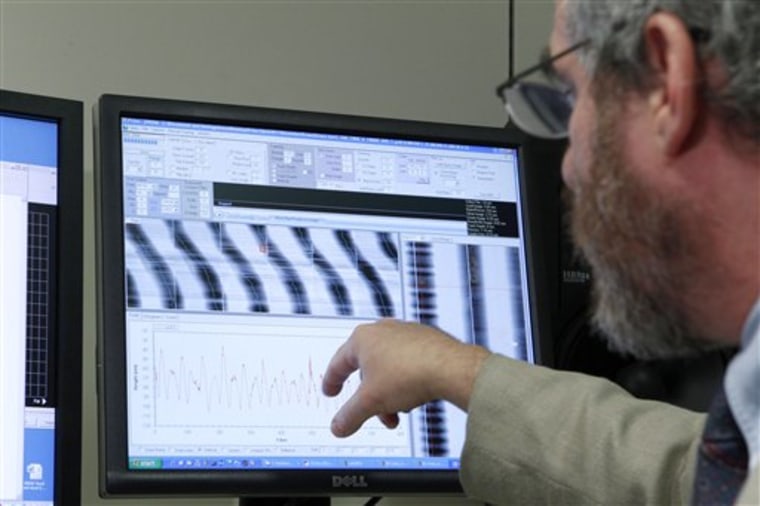Alexander Graham Bell foresaw many things, including that people could someday talk over a telephone. But the inventor certainly never could have anticipated that his audio-recording experiments in a Washington lab could be recovered 130 years later and played for a gathering of scientists, curators and journalists.
"To be or not to be..." a man's voice can be heard saying in one recording as it was played on a computer at the Library of Congress on Tuesday. The speaker from the 1880s recites a portion of Hamlet's Soliloquy as a green wax disc crackles to life from computer speakers.
The early audio recordings — which revealed recitations of Shakespeare, numbers and other familiar lines — had been packed away and deemed obsolete at the Smithsonian Institution for more than a century. But new technology has allowed them to be recovered and played.
The technology reads the sound from tiny grooves with light and a 3D camera.
The recordings offer a glimpse into the dawn of the information age, when inventors were scrambling to make new discoveries and secure patents for the first telephones and phonographs, even early fiber optics.
A second recording, on a copper negative disc, reveals a trill of the tongue and someone reciting the numbers 1-2-3-4-5-6.
A third recording catches perhaps the first sound of disappointment as Bell's recording device seemed to hit a technical glitch.
"Mary had a little lamb and its fleece was white as snow," a voice says. "Everywhere that Mary went ... Oh no!"
On Nov. 17, 1884, Bell's lab recorded the word "barometer" several times on a glass disc with a beam of light. It and about 200 other experimental records were packed up and given to the Smithsonian, seemingly never to be played again.
Hotbed of innovation
The recordings date back to the 1880s. Bell had moved from Boston to Washington after obtaining a patent on March 10, 1876, for his invention of the telephone, which occurred when his employee Thomas Watson heard him shouting over a wire in the next room. He joined a growing group of scientists who made the nation's capital a hotbed for innovations.
Bell partnered with his cousin Chichester Bell and Charles Sumner Tainter to create Volta Laboratory Associates in Washington in the early 1880s.

During this time, Bell sent the first wireless telephone message on a beam of light from the roof of a downtown Washington building — a forerunner to modern fiber optics. He and other inventors also were scrambling to record sound on anything they could find, including glass, rubber and metal. One early sound record looks like a smashed soup can.
Inventors at the time were in intense competition. Bell, Emile Berliner and Thomas Edison, who invented the phonograph to record sound on tin foil in 1877, each left objects and documentation with the Smithsonian to help prove their innovations were first.
Bell went so far as to seal some devices in tin boxes for safe keeping at the Smithsonian. Edison's earliest recordings are thought to be lost.
"This stuff makes the hair stand up on the back of my neck," said Curator Carlene Stephens of the National Museum of American History before Bell's recordings were played Tuesday. "It's the past speaking directly to us in a way we haven't heard before."
Key resource for research
The museum's collection of about 400 of the earliest audio recordings, including 200 from Bell's lab, will likely become a key resource for new research on communications and early technology now that they can be played back, Stephens said.
"These materials have been in a cupboard and virtually unknown for decades," she said. "The collection has been silent."
The Library of Congress partnered with the Lawrence Berkeley National Laboratory at the University of California at Berkeley to offer the first listen of these early recordings on Tuesday. Scientists have spent the past 10 years and about $1 million to develop the technology to create high-resolution digital scans of the sound discs.
This year, scholars from the Library of Congress, the Berkeley Lab and the Smithsonian gathered in a new preservation lab at the Library of Congress and recovered sound from those early Bell recordings. A $600,000 three-year grant from the U.S. Institute of Museum and Library Sciences funded the pilot project, and the Smithsonian hopes to continue the work if future grants can be secured.
Computers make it easier
Advances in computer technology made it possible to play back the recordings, Haber said, noting that 10 years ago specialists would have struggled with computer speeds and storage issues. The digital images that now can be processed into sound within minutes would have taken days to process a decade ago.
Many of the recordings are fragile, and until recently it had not been possible to listen to them without damaging the discs or cylinders.
So far, the sounds of six discs have been successfully recovered through the process, which creates a high-resolution digital map of the disc or cylinder. The map is processed to remove scratches and skips, and software reproduces the audio content to create a standard digital sound file.
Carl Haber, senior scientist at the Berkeley Lab, said Bell's recordings and others in the fierce competition of the 1880s marked the start of the information age as we know it.
"The whole idea that you could capture the world as it exists" in a recording, he said, "they got that in this period."